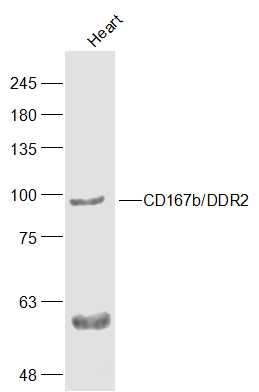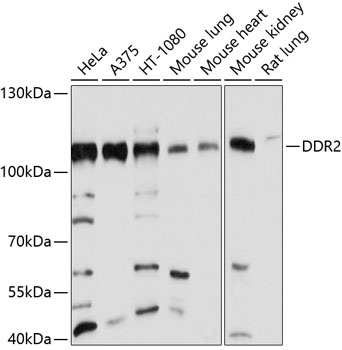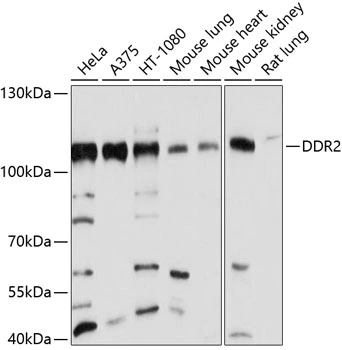![ICC/IF analysis of A549 cells using GTX83062 DDR2 antibody [3B11E4]. Green : DDR2 Blue: DRAQ5 fluorescent DNA dye Red: Actin filaments ICC/IF analysis of A549 cells using GTX83062 DDR2 antibody [3B11E4]. Green : DDR2 Blue: DRAQ5 fluorescent DNA dye Red: Actin filaments](https://www.genetex.com/upload/website/prouct_img/normal/GTX83062/GTX83062_20170912_ICCIF_w_23061322_240.webp)
ICC/IF analysis of A549 cells using GTX83062 DDR2 antibody [3B11E4]. Green : DDR2 Blue: DRAQ5 fluorescent DNA dye Red: Actin filaments
DDR2 antibody [3B11E4]
GTX83062
ApplicationsImmunoFluorescence, Western Blot, ELISA, ImmunoCytoChemistry, ImmunoHistoChemistry, ImmunoHistoChemistry Paraffin
Product group Antibodies
TargetDDR2
Overview
- SupplierGeneTex
- Product NameDDR2 antibody [3B11E4]
- Delivery Days Customer9
- Application Supplier NoteWB: 1/500 - 1/2000. ICC/IF: 1/200 - 1/1000. IHC-P: 1/200 - 1/1000. ELISA: 1/10000. *Optimal dilutions/concentrations should be determined by the researcher.Not tested in other applications.
- ApplicationsImmunoFluorescence, Western Blot, ELISA, ImmunoCytoChemistry, ImmunoHistoChemistry, ImmunoHistoChemistry Paraffin
- CertificationResearch Use Only
- ClonalityMonoclonal
- Clone ID3B11E4
- ConjugateUnconjugated
- Gene ID4921
- Target nameDDR2
- Target descriptiondiscoidin domain receptor tyrosine kinase 2
- Target synonymsMIG20a, NTRKR3, TKT, TYRO10, WRCN, discoidin domain-containing receptor 2, CD167 antigen-like family member B, cell migration-inducing protein 20, discoidin domain receptor 2, discoidin domain receptor family, member 2, discoidin domain-containing receptor tyrosine kinase 2, hydroxyaryl-protein kinase, migration-inducing gene 16 protein, neurotrophic tyrosine kinase receptor related 3, receptor protein-tyrosine kinase TKT, tyrosine-protein kinase TYRO10
- HostMouse
- IsotypeIgG2a
- Protein IDQ16832
- Protein NameDiscoidin domain-containing receptor 2
- Scientific DescriptionReceptor tyrosine kinases (RTKs) play a key role in the communication of cells with their microenvironment. These molecules are involved in the regulation of cell growth, differentiation, and metabolism. In several cases the biochemical mechanism by which RTKs transduce signals across the membrane has been shown to be ligand induced receptor oligomerization and subsequent intracellular phosphorylation. This autophosphorylation leads to phosphorylation of cytosolic targets as well as association with other molecules, which are involved in pleiotropic effects of signal transduction. RTKs have a tripartite structure with extracellular, transmembrane, and cytoplasmic regions. This gene encodes a member of a novel subclass of RTKs and contains a distinct extracellular region encompassing a factor VIII-like domain. Alternative splicing in the 5 UTR results in multiple transcript variants encoding the same protein. [provided by RefSeq, Jul 2008]
- Storage Instruction-20°C or -80°C,2°C to 8°C
- UNSPSC12352203

![IHC-P analysis of human skeletal muscle tissue using GTX83062 DDR2 antibody [3B11E4]. IHC-P analysis of human skeletal muscle tissue using GTX83062 DDR2 antibody [3B11E4].](https://www.genetex.com/upload/website/prouct_img/normal/GTX83062/GTX83062_20170912_IHC-P_w_23061322_271.webp)
![WB analysis of truncated DDR2 recombinant protein using GTX83062 DDR2 antibody [3B11E4]. WB analysis of truncated DDR2 recombinant protein using GTX83062 DDR2 antibody [3B11E4].](https://www.genetex.com/upload/website/prouct_img/normal/GTX83062/GTX83062_20170912_WB_w_23061322_261.webp)






